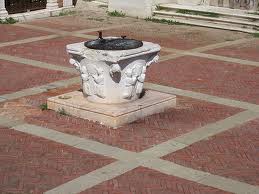Brick Pavement: Difference between revisions
Jump to navigation
Jump to search
No edit summary |
No edit summary |
||
| Line 1: | Line 1: | ||
[[File:Brick pavement.jpg|right|thumb|300 px|an example of a paved ''campo'']]The first walkways in Venice were paved in 1264.<ref>G. Tassini, ''Curiosita Venezia'', (6th edition, 1931)</ref> These paved walkways were called ''[[ | [[File:Brick pavement.jpg|right|thumb|300 px|an example of a paved ''campo'']]The first walkways in Venice were paved in 1264.<ref>G. Tassini, ''Curiosita Venezia'', (6th edition, 1931)</ref> These paved walkways were called ''[[salizada]]'' and were composed entirely of [[brick]]. Over time the bricks became weathered and needed to be replaced. In 1676 ''[[masegni]]'' stones were introduced and used to restore the majority of [[streets]]. | ||
Now, [[brick]] pavements make up only 2% of paved walk ways in Venice. | |||
== See Also == | == See Also == | ||
Latest revision as of 16:43, 16 June 2014

The first walkways in Venice were paved in 1264.[1] These paved walkways were called salizada and were composed entirely of brick. Over time the bricks became weathered and needed to be replaced. In 1676 masegni stones were introduced and used to restore the majority of streets.
Now, brick pavements make up only 2% of paved walk ways in Venice.
See Also
References
- ↑ G. Tassini, Curiosita Venezia, (6th edition, 1931)